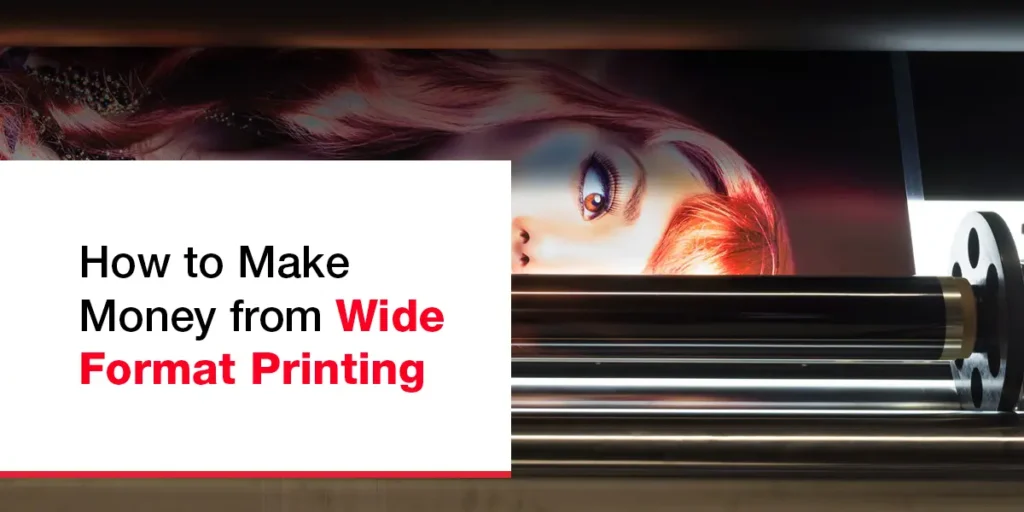
It’s important to understand the basics of inkjet print, but without being seduced by the technology. Inkjet is primarily just a print method that turns images into money. Yes, there’s a lot of science, technology and chemistry built-in, but it’s what inkjet does – fast turnaround and economic short runs; print on anything with great image quality – that’s important.
Wide format generally refers to printing on media up to 5 meters wide. Within this category, printing from 2.4m to 5m width is sometimes called ‘super-wide’ or ‘grand-format’. Printers come in two basic formats: roll-fed (PVC for banners, wraps, textiles, etc.) or flatbed (card, board, Perspex, lenticular, glass, wood, metal, rigid PVC and Polystyrene etc.)
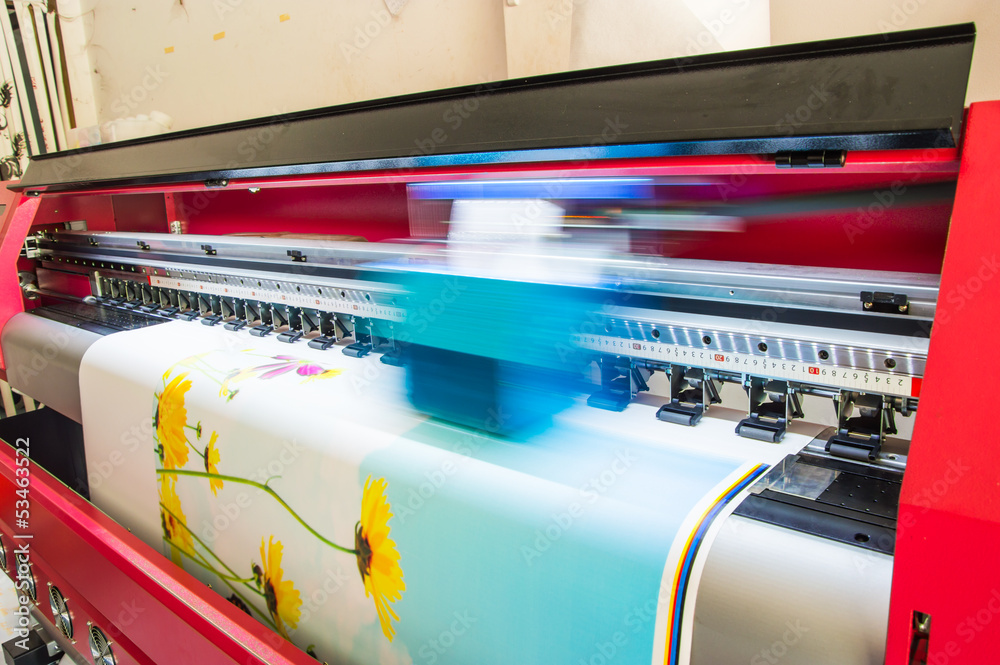
There are significant differences between an offset workflow and an inkjet digital workflow.
Compared to litho and screen printing, inkjet is a much simpler process. In essence, the pre-press stage – including the time and cost of labor and consumables – is eliminated. There are no screens or plates to prepare. Files go through a RIP in the same way, then the printer works in pretty much the same way as a desktop machine. The process is extremely fast to set up, and there’s little delay in moving on to the next job. This short turnaround time and back-to-back scheduling means inkjet printers can be running continuously.
Inside the printer, the software converts the image to a series of ones and zeroes that tell the print head to jet a microscopic drop of ink, or not to. This is called drop-on-demand inkjet. Most wide format printers use piezo-electric printheads. Inside the printhead, ink from a reservoir fills a tiny chamber.
One of the walls of the chamber is made from piezo-electric ceramic. A minute electric charge is applied to the ceramic. Thanks to the unusual properties of this material, it changes shape in a very predictable way, forcing ink out through a minute nozzle in the chamber and onto the substrate. For printers working at high speed, the size of the drop is critical: too small and it gets buffeted by moving air; too big and the print definition suffers.
Inkjet inks most often come in the usual four-color systems. Increasingly printers come with options for additional colors. White is commonly used to make clear film opaque. Some systems offer additional light cyan and light magenta to give more accurate colors. Occasionally a range is augmented by additional green, orange and violet to stretch the gamut as widely as possible. UV Ink To print in high definition, drops of ink jetted onto a substrate need to be small. This, in turn, means the nozzles are tiny. To make sure they don’t block, the ink needs to be absolutely pure.
In Fujifilm’s Uvijet range, the particles of pigment are less than one micron in diameter. That’s under one-thousandth of a millimeter, several times smaller than the tiniest human cell. Uvijet is manufactured in a purpose-designed manufacturing facility at Fujifilm’s base in Broadstairs. Digital ink is made in small, high-quality batches. A UV formulation typically uses twenty to twenty-five ingredients compared to the seven to ten in a solvent-based recipe. Digital UV ink is produced using custom-designed dispersion equipment developed jointly by Fujifilm and the manufacturer.
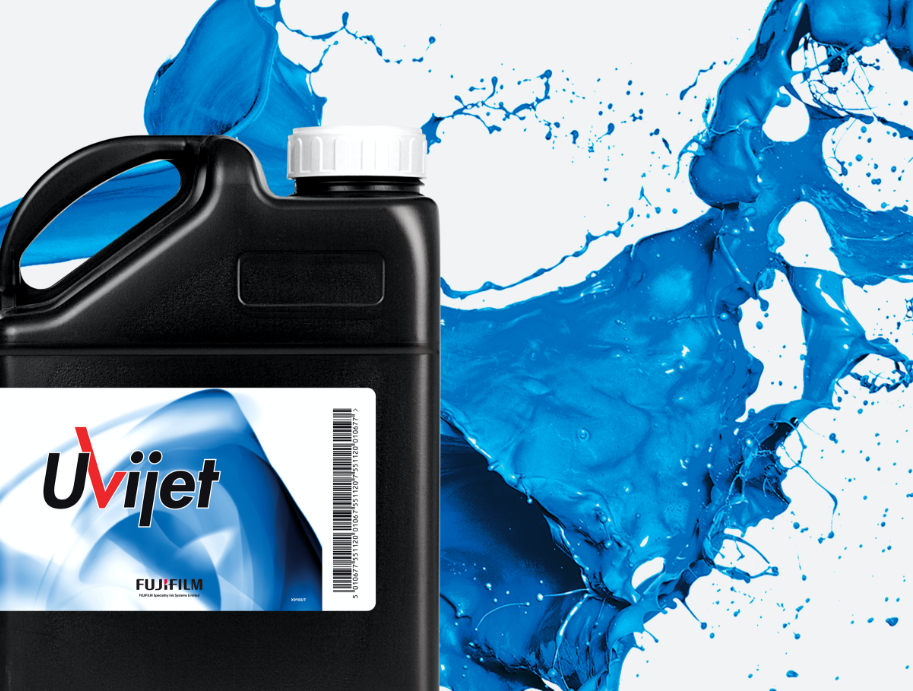
Pigment is milled down to a smaller size under great pressure over many hours using specialist grinding equipment. The process reduces the size of particles from fifty to below one micron in size. They start roughly the size of a grain of salt, being ground down in size to smaller than a human cell. This process – unique to Fujifilm – is called Micro-V Dispersion.
After blending the ink into the four standard colors, Fujifilm uses pharmaceutical-standard filters to make sure no unwanted particles end up in the finished product. The end result of this painstaking process is UV inks that are significantly brighter, stronger, more vibrant, and more reliable than any others on the market. UV ink is cured nearly instantly by radiation emitted in the ultra-violet spectrum. To generate the fastest print speeds, ink and UV lamps are fine-tuned to cure after an exact dose at a precise wavelength.
The UV radiation initiates a reaction causing the monomers in the ink to polymerize, trapping the color pigment. Solvent ink Many roll-fed machines use solvent-based ink which is flexible and less prone to cracking. Ink dries by evaporating the solvent, leaving the pigment and binder on the media to form an image. Fujifilm’s range of digital solvent ink is called Color+. It is tailored to suit the printheads of each make of machine. Customers often buy it after the equipment warranty, which usually stipulates own-brand ink, runs out. Color+ offers better colors, superior quality and, through better mileage, lower costs in the long run.
Solvent inks in general give strong, durable colors suitable for outdoor use. On the other hand, they do produce an odor, and formulations have to be carefully designed to minimize harmful solvents. Digital solvent inks can contain 70% or more volatile material. Volatile organic compounds (VOCs) are environmentally undesirable and are controlled by regulations. Businesses can only emit a limited quantity of these before they are obliged to burn or recycle them. Recent developments in the form of eco-solvent printers and inks have tried to address the problem.
On a flatbed printer, either the vacuum bed carrying the substrate moves underneath the printheads using precision-engineered linear motors, or the bed is fixed and the printheads pass over the substrate (Acuity for example). At each pass, ink is jetted to the exact location the RIP sends it to, building up the image. To make sure the image is precise, the substrate is held securely by a vacuum bed ‘pulling’ it down. The mechanism has to be precise enough to allow for double-sided or ultra-fine lenticular print.
Depending on the size of the substrate, areas of the flatbed might be uncovered, which would mean too little pressure to hold the media. To get around the problem, some manufacturers build in several vacuum zones to fit popular sizes of media. Others recommend a masking blanket to cover the unused areas of the bed.
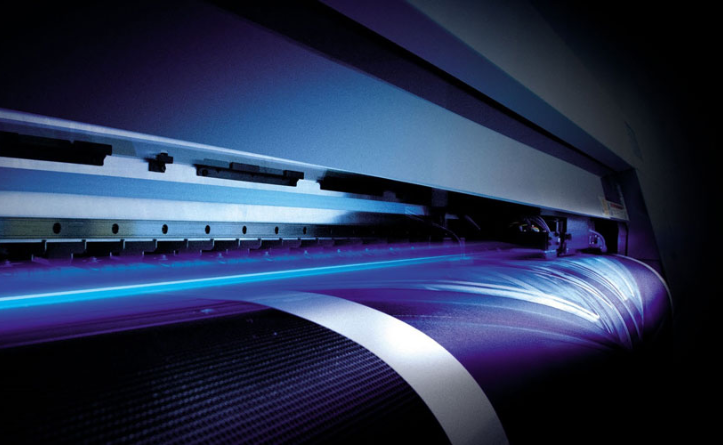
Inkjet printers can work with a range of substrates. These can be rigid or flexible, depending on what the printer was designed to work with. While rolled substrates are limited to just a few millimeters in thickness for obvious reasons, flatbeds can handle rigid media up to 50mm in depth. Flatbed printers can print on paper, board, PVC film or rigid materials like acrylics or foam-centered board for graphic displays. They can even print on glass or wood – in fact, any material up to their ‘ride height’. Applications Beyond the conventional range of card, board and vinyl, flatbed printers have been used to decorate glass, metal, slate, fabric and wood, introducing a range of applications limited only by the imagination.
Walk down any high street and you will see thousands of examples of wide format graphic print, indoor and outdoor, on buildings, in shop displays, on vehicles, at bus stops. In shops, floor graphics guide our footsteps, three-dimensional POP tempts us to pick up and purchase, signs guide us to the products we want, special offers encourage us to buy what the shop wants us to.
Litho printers are accustomed to looking closely at print, whereas graphic display is meant to be seen from meters away. It’s widely thought by traditional litho printers that inkjet print isn’t good enough for buyers. But those buyers already choose inkjet print every day of the week for those components of campaigns that litho printers don’t supply. The most accurate digital printers will produce 4-point reversed text with clarity, which is more than acceptable for close viewing, being roughly equivalent to 1,440 dpi.
Wide format printing measures print speeds by determining how many square meters of print the printer can produce in one hour. Most printers can print at varying speeds, with slower speeds often achieving higher quality and faster speeds while sacrificing some amount of quality.
Fujifilm’s approach to innovation has always been application-driven. We have sought to find not only the right solutions but also to answer the right questions. We’ve chosen to work on developments that make a genuine difference to printers, rather than for their own sake. The printers we pick are the best in their field, the most fit-for-purpose.
As a company, Fujifilm influences the technology of wide format more than any other. We contribute to the design of (and distribution of) the Inca range of flatbed printers. Uvijet and Color+ inks are the highest quality inks available, known to give the strongest, most vibrant colors. And the best performing printheads, from FUJIFILM Dimatix, are found in all Inca machines. The result is that we can guarantee consistency and color to high, offset specifications, not to mention the best long-term profit opportunities.
The wide format market is predicted to be worth $11.2 billion by 2025. Everywhere around us, we can see banners, posters, point-of-sale, window stickers, vehicle wraps fuelled by developments in printers, ink and media. The recent history of wide format is the story of the dramatic shift from traditional screen print to inkjet.
Screenprint, despite the Jeremiahs, is far from dead. At print runs beyond 500-off, it is still the more cost-effective technology. Screen is still the best way to print metallic and fluorescent finishes. While a number of inkjet-only businesses exist, many of the screen firms that migrated from screen to inkjet have kept some screen capability, as long as they have the skills to perform screen printing. Unlike inkjet, screen print is more art than science and press operators need to be skilled. As a result, we still see applications combining screen and inkjet print to produce richly-finished graphics.
Screenprint, from a workflow perspective, has many parallels with offset litho. In principle, there is a costly and time-consuming pre-press phase. Once set up, presses can produce high-quality print in long runs. While digital processes suffered initially from weaker quality, they have the great advantage of being able to print almost instantly, usually within minutes. Short print runs are therefore faster and cheaper.
The introduction of UV-curing inks with fast drying and precision engineering has brought speed and accuracy. The result is fast, high-definition print that pushes both screen and offset further away from short-run campaigns. Both roll-fed and flatbed machines have developed side by side over the last ten years.
Flatbed printers use rigid, thick media for substrates. This has an influence on printer speed, with common wide format printers reaching 150m2 per hour of output. Some can be even slower than that. In recent years, Fujifilm has paved the way for faster wide format printing speeds, with older product models reaching 700m2 per hour. Today’s wide format printers from Fujifilm outshine even that.
The Acuity Prime series lets you enjoy rapid job turnover to achieve new heights in productivity. The latest technological enhancements give it some incredible benefits, including an ultra-fast job setup time and print speeds reaching 1,615ft2 per hour. Enjoy greater productivity than ever with the latest technology from Fujifilm found in the Acuity Prime series of UV flatbed, wide format printers.
The essential equation for inkjet has always been the one that determines the print run beyond which it becomes more economic to use screen, assuming acceptable quality print. To get some idea of how fast technology has forged ahead, the ESMA Screen Printer’s Guide to Digital Flatbed Printing in 2003 was talking about an economic crossover of around 150-off. It says that the top machines were expected to match the cost of 4-color at up to 250 prints “in a few years.”
In the nearly two decades since that information was released, Fujifilm has smashed those expectations and gone far beyond market projections. Before the Acuity Prime series, Fujifilm’s wide format printers were already pushing an economical number around 1,000-off, and Acuity Prime series printers can take it even further. You get economical printing, even when handling customized, shortened print runs.
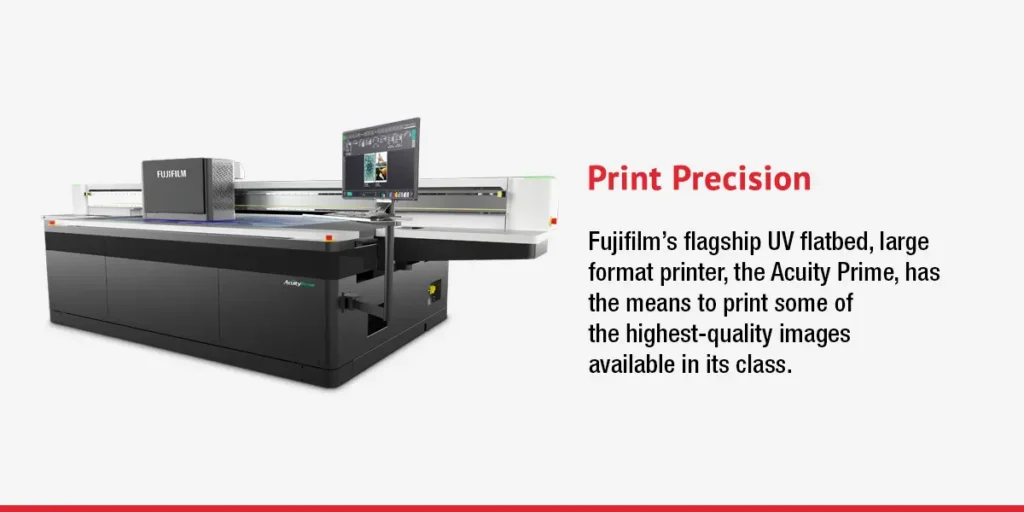
While objectively less precise than litho print, inkjet results have improved considerably, far beyond ‘fit-for-purpose’ criteria. Most graphic print is designed to be viewed from some distance. Printhead advances mean that some machines can jet 4 point reversed text quite legibly onto suitable media.
Fujifilm’s flagship UV flatbed, large format printer, the Acuity Prime series, has the means to print some of the highest-quality images available in its class. This is thanks to its Gen 5 printheads in up to 7 channels that you can configure in a variety of ways to suit your purposes. You can even achieve high print precision at high speeds with the Acuity Prime series, thanks to its state-of-the-art mechanical components and consistency.
Whether up close or far away, printings from an Acuity Prime series UV flatbed, wide format printer will look fantastic.
As wide format has migrated from screen, a subtle shift in approach to business development has taken place. While cost and quality were once the criteria, value-added aspects of wide format have emerged. Wide format firms often have creative departments working with buyers suggesting new media, designing 3-D POP and helping to find great answers to promotional challenges. In turn, buyers have become much less concerned about print methods. They’re looking at applications and focusing on value rather than cost.
All non-direct-to-paper print processes involve chemicals to prepare and clean up, and some of these are decidedly unpleasant. Printers and suppliers have come under pressure to make their processes more environmentally friendly. The advent of computer-to-screen has greatly reduced the number of chemicals used in prepress. But the biggest advance has been the transition to digital print, which is inherently cleaner as well as less wasteful.
Machines print the exact quantity we tell them to. And because they print on demand, buyers don’t need to hold stocks. UV inks, too, play a big part. They contain no volatile organic compounds (VOCs). One hundred percent of UV ink ends up on the media, compared to just 20% with solvent ink. That said, UV has drawbacks – it can become brittle and crack.
Solvent inks stretch and are more suited to some specialist products such as vehicle wraps. Some equipment manufacturers such as Epson, Mimaki and Roland have turned to eco-solvents made without VOCs. HP has launched a latex ink which does away with ventilation and staff training for hazards, While all these do away with the need for air-cleaning systems, they dry more slowly and need a heat source in the machine. As a result, they use more energy.
Besides chemicals, another environmental concern for all printers is recycling. Wide format equipment can print onto a wide range of substrates. Much production has moved to PVC-free media such as polyethylene material, which bio-degrades more rapidly. But recycling paper isn’t easy.
A couple of companies have started media recycling schemes, but these deal with just a fraction of current print output. They do, however, make good headlines and sustainability is becoming more important to buyers. The green argument says that buyers will prefer environmentally conscious suppliers, so you will increase sales. Reducing energy and eliminating wasted print saves money. Making the move now insures you against future regulations and you get to work in a better environment.
All are important, but the telling point is that buyers’ expectations are heading in the direction of better sustainability. Under pressure to reduce carbon footprints, they want suppliers to help them. If it’s a choice between two equally qualified suppliers, the greener will win.
Future developments will include printers that provide management information. The aim is to arm printing companies with the information they need to get the best performance and lowest costs from their machine.
One factor to consider is that in the printing industry, buyers have a tendency to overorder. This leads to excessive amounts of material and ink waste, and unnecessary wear and tear on the printing machines used to create these prints. Customers may not use all their printed materials after they purchase and receive their order.
Consider a buyer wanting 3,000 prints. The printing company gives the buyer quotes for 3,000-off, 4,000-off and 5,000-off. After considering the length of time it will take to receive their prints, the buyer may choose to get the 4,000-off package at its slight price increase instead of the 3,000-off to make the most of their waiting period.
In the end, they may have at least 1,000 prints go unused. If the information included on those prints goes out-of-date, then the amount of waste can be even higher.
If you ignore the environmental implications of this waste, you can feel good about upselling the buyer and making a bit more money. But in today’s market, buyers are more conscious of waste than ever. You should strive to price your tiers to encourage buyers to get the proper amount and make environmentally conscious purchasing decisions.
Efficient printers like the Acuity Prime series can help you achieve greater wide format printing sustainability and a larger return on your investment (ROI) in your printing business.
The question may arise of whether there is still a market for wide format printing. It’s important to understand that wide format industry trends keep up with the changes that arise as time goes on.
Even with the popularity of music streaming services, a market still exists for vinyl records and CDs. The same applies to wide format printing services. Even as people do more advertising on the internet and various social media websites, the need for physical advertising is still strong. This is because physical communication is less volatile than online communication.
Internet fads change. A social media website that is popular today may become unpopular tomorrow. Plus, online ads can have trouble reaching their target audience thanks to ad blockers and other online safeguards.
This is where wide format printing takes the stage. Think of all the billboards you pass along the highway or the compelling ads you see in shop windows. Even the sides of buildings can be great places for companies to advertise their products and services.
Successful advertising will always include a graphical aspect, and wide format printing is often the best way for these companies to achieve such beautiful and effective physical ads.
Embracing new opportunities in printing is key to every printing business’s success. Consider the shift from screen printing to digital printing within the last several decades. Companies that switched to digital early found success in the years to come.
The current printing industry is shifting toward an emphasis on sustainability, efficiency and quality. If you embrace these changes and view them as an opportunity to please the customers in your market, then you’re sure to achieve a better wide format printing ROI than if you chose to resist the market changes.
You need industry expertise in your assets to stay profitable, and Fujifilm can provide that expertise. For 50 years, Sericol was a pioneer in the screen ink industry. After becoming a part of Fujifilm, Sericol is now a leader in the wide format printing market, selling top-of-the-line inks, applications and machines for inkjet printers.
Thanks to this development, Fujifilm is able to draw on even more of the top minds in the market for wide format printing and share this knowledge with you through its products.
Those of us who work in the world of offset litho print needs little introduction to the day-to-day pressures of the industry, but it’s worthwhile taking a step back to view the wider panorama. Declining sales and falling margins are not untypical.
Ultimately, it’s our fault as consumers. Older consumers retain an affinity for newsprint and magazines. Younger people are happier with electronics and view the world in a transient state. For much of industry, the business model has shifted from ownership to access: once the only way to enjoy music (legitimately) was to buy a CD, cassette tape or vinyl record. Now people download music song by song or pay for unlimited access.
Like policemen, the media planners for advertising agencies are getting younger. They belong to the social media generation. They buy integrated, cross-media campaigns, target tight profiles and personalize messages to make the best impact, which they measure in terms of response rather than reach. With so many online and mobile avenues to promote brands, inevitably traditional advertising carriers have suffered.
Many, if not most, large companies offer the option of downloading brochures and reports as PDF files from their websites. Even Governments and local authorities supply pretty much every form and notice online. With lower demand for preprinted hard copies, print runs are declining. With the availability of on-demand digital print, brands are unwilling to carry large stocks.
According to the headlines, or at least the press releases, print management specialists are doing well. Over time, companies such as HH Print Management, Webmart and Williams Lea have signed up many of the big brands. Their proposition to brands is simple: they save cost and management time. And since their modus operandi is to auction jobs to (painstakingly!) pre-qualified printers, usually buying the lowest price, they tend to drive margins down. For commercial printers, about a third rely on print management companies for a substantial part of their turnover.
We’ve seen it all before. The pressure on traditional marketing tools is becoming more intense. Direct mail and statement enclosures have to be highly personalized and targeted otherwise they jump from envelope to recycling bin. Brands, therefore, need to make a bigger splash in a sea of routes to market. Ambient media is growing – there’s scarcely a bus ticket that doesn’t promote some local service. But the biggest waves come from display print. Walk down any high street to see buses, taxis, buildings and shop windows dripping with graphics. If retailing is a battlefield, point of purchase (POP) is the front line. The measure of materials deployed at the moment-of-truth zone is how effectively they extract money from our pockets. POP is therefore value-adding rather than a cost.
Marketers no longer broadcast messages and hope for the best. They dice audiences into ever finer slices and zoom in on the best way to communicate with them, whether traditionally or using electronic media. In the high street, campaigns are personalized to individual stores or branches. Competitive pressures being what they are means that sales promotion turnaround times are measured in hours. Wide format inkjet technology delivers on-demand print and handles variable data for customization without a blink.
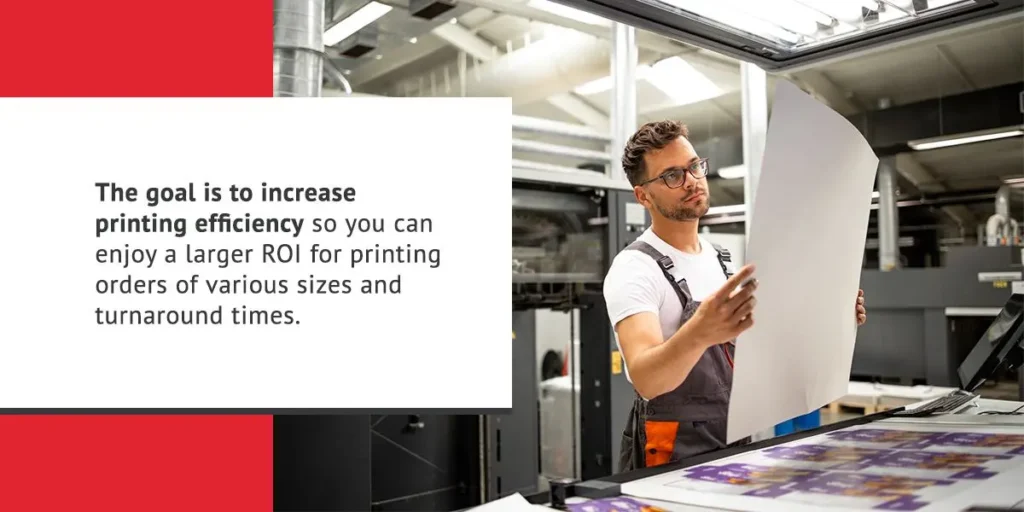
Even as other mediums like the internet come into play, wide format printing is still growing — for those who respond to industry trends and changes. The goal is to increase printing efficiency so you can enjoy a larger ROI for printing orders of various sizes and turnaround times, which can be achieved with the Acuity Prime series. Companies who stick with their old gear, turn a blind eye toward wide format printing and ignore industry changes may find themselves lagging behind the competition.
Market changes are inevitable in the printing industry, but you can view this change as an opportunity rather than a roadblock. As more companies seek wide format printing to meet their needs, your printing company can embrace this change to meet the demand. This is why adopting modern printers like the Acuity Prime series can yield such a high ROI in printing businesses.
Wide format offers print firms an attractive way to diversify and open up new revenue streams. It’s a market that is growing and a crucial aspect of pricing is about reflecting added value.
Wide format print offers bigger margins to the producers. At a time when offset margins languish in single figures, widformat opens up a world in which value exerts a stronger pull. Like the print they order, buyers of wide-format print can come in a variety of shapes and sizes.
Print management companies are still there, but also there are many advertising and promotion agencies. In the case of some large brands, an in-house creative team may be involved, often with a specialist print buyer. Exhibition builders, architects and building managers crop up. All these are, of course, new potential customers for offset print.
More importantly, wide format buyers are interested in capability: how you tackle novel challenges; what you can suggest; how creative you are; how much value your product adds. These buyers tend to stick with suppliers. The uniqueness of one-off projects means price comparisons are tricky, but often it’s not the main concern.
One Fujifilm customer, for example, with a reputation for printing on textiles, especially carpet, was approached to produce and fit a 1681m2 Monopoly board design on the carpet for an exhibition. Price was not the main consideration – getting it fitted in time and being able to take it to other venues were more important.
Advances in technology allow wide format companies to offer a broader range of print and enjoy increased revenues.
Most printers say it’s at least as profitable as their main business; for many, it is more lucrative. Wide format presses are designed to handle short runs and they need less human input to run them. A lot of wide format jobs are sales promotions that demand fast turnaround, for which buyers are prepared to pay premium prices for high-quality print and service.
Profitability is the main attraction for any printer contemplating a move into wide format printing. The higher level of profitability derives from the creative nature of wide format print. Often printers are invited to contribute to design ideas, for example advising on novel 3-D structures. They are adding significant value, which buyers are content to reward.
Wide format, by its nature, tends to involve non-print services. Banners need to be displayed; POP placed; window graphics applied; vehicles wrapped; posters mounted. All these are opportunities to boost income and earn better margins. By way of example, a Fujifilm customer was able to produce a 65m by 10.4m wrap for three sides of a department store on a PVC mesh.
The material stretches and flexes a good deal, so the firm had to work out exactly by how much in order to leave the buyer’s logo and messages precisely where specified. As a result, the company won an order to repeat the exercise every six weeks.
Importantly, our customer was asked to mount the wrap in a frame around the store, at night, using a crane in a closed-off road, with no mistakes and no overrunning. The buyer was not looking for the lowest cost, rather the most reliable and accurate supplier.
Multi-format printers are rounded businesses capable of selling full solutions, not just parts of campaigns. They’re comfortable with printing projects handling new applications on a wide range of media. They are willing to respond fast to last-minute promotions. Above all, they are natural diversifiers, willing to experiment, keen to become more capable. Wide format inkjet print is more about value than the cost of ink and paper. Its focus is on content, and the task is to communicate that to target audiences.
The response of the reader or viewer determines the value to the buyer. The tighter the targeting, the more appropriate the message, the better the response and the higher the value. Digital print is good at handling variable data files. In the context of wide format, this might mean personalizing POP and display to individual stores, with different prices or different promotion dates. Printers who expand into wide format earn the opportunity to participate in the full campaign, not just the offset print part.
That’s convenient for buyers and gives them consistent colors and production values across a range of media.
When a buyer enquires about litho, the typical response is how many, when, what size and how many colors. It’s pretty much the same picture with screen printing. Usually, buyers want a quote on the spot. There’s no great incentive to form a lasting relationship and to return to buy more. Wide format printers are much noisier – in a good way.
They get to ask about what the print is for, where it’s going, what it’s supposed to do, who’s going to install it, and where does the information needed to print it come from? In the case of 3-D print, for instance, there needs to be a collaboration over design and testing. As a consequence, wide format printers get involved with the execution of campaigns, beyond the actual print. They often deliver and physically display the material – not always directly. But the extra services allow them to charge and earn additional margin. It’s a service that litho printers could easily do.
The product may be print, but the margin lies in project management, from creation to installation, and in the logistics of the whole campaign. Litho printers are reluctant to invoice for anything that is not ink on paper, partly because of the commoditized nature of litho print. If a job involves an unexpected amount of management and phone calls for, say, checking files or sorting out data management problems, commercial printers can be reticent about speaking to a buyer and advising them they need to charge more.
They fear, with some justification, that the buyer will take the business to a competitor who’ll throw in the additional work for nothing. The culture of wide format is different. Suppliers are less shy. On creative projects, they can say they understand the brand’s business and are performing a unique, tailored service. There is no embarrassment in asserting that there’s value in their service. Invoices tend to reflect the project management element rather than be a simple sum of paper, machine time and ink. If you’ve always worked in a particular way, it might be too uncomfortable to change in one fell swoop. But Fujifilm can help.
We understand the wide format market – Fujifilm has been a leading player in the development of wide format for decades.
Margins on routine commercial work languish in single figure percentages. Some jobs don’t even offer that. Printers are reluctant to turn away work – lease payments on presses have to be met and employees paid, whether or not they’re busy. Sometimes it’s tempting to take on a job just to put work on the press.
Naturally, this encourages buyers to shop around looking for spare capacity – firms with no work on. But it doesn’t create any loyalty – good service is forgotten fast. When the next job turns up, the buyer or broker goes hunting again for spare capacity around the market. The printers who are successful and are making fair margins are those that have broadened their print capability and developed an in-house creative service, coupled with account management skills.
Wide format buyers are different. Selling to them involves a switch from remote publishers buying quantity for the cost to creative buyers looking for ideas, speed and novelty in a generally collaborative relationship. Few litho customers have a relationship with brand owners. Where they talk to creative agencies at all, contacts are with print buyers.
Getting involved in wide format print means moving up the food chain – not just taking orders but contributing ideas and knowledge. This means printers need to raise their game in communicating with buyers. Equally, print firms need to promote themselves to a different audience of buyers. So our recommendation to commercial printers is this: for important potential buyers, try to meet them face-to-face.
Specifically:
A printer who gains a reputation for being able to place print onto a range of substrates will, sooner or later, get calls asking about further unusual jobs. At this point, the buyer is less sensitive about price and more thankful to find a supplier.
Thanks to the changes in technology, entering the wide format print market is more lucrative than ever. Technology is advancing, making commercial wide format printers easier to obtain. Change can seem daunting, but it is the way your business can experience explosive growth. Now is the time to prepare and make moves toward wide format printing. Start making your wide format printing business plan today.
At Fujifilm, we talk all the time to our customers about the state of their business, their plans and ambitions. Fujifilm’s job is to help you make the change. We’ve known the wide format market and been a leading ink producer for over fifty years. We anticipated the switch from screen to inkjet and have been at the forefront of wide format inkjet print for ten years or more. Like litho printers, we’ve been faced with the prospect of losing a huge part of our revenue unless we changed direction Fast.
We can help you to:
Litho printers often say that print quality from inkjet isn’t good enough for litho customers. But the same brands buying litho do use inkjet print already. They deploy banners, POP, 3-D display, window films, floor graphics and vehicle wraps up and down the high street to promote magazines and newsprint. It’s just that they buy it from someone else.
Many printers peer at inkjet print close up and make comparisons with litho. In fact, inkjet print is typically designed for viewing from some distance, often meters away. Even so, high-resolution printers with variable drop technology achieve near-photographic results with resolutions equivalent to 1440 dpi. Four-point reversed text is perfectly achievable if needed.
Most firms focus on the start-up costs or cost of entry. If so, wide format machine costs should be a pleasant surprise: inkjet printers range from the sort of prices litho presses command all the way down to models suitable for a one-man shop. More important are the running costs, especially selling costs.
Quoting prices is not selling. The relationship-based nature of wide format calls for sound account management. This is a skilled sales role that printers will need to invest in. The best thing a firm moving into the wide format market can do is to hire someone charged with bringing in business and managing relationships.
Another aspect that printers should factor in is that wide format turnaround time is important. Buyers can turn up out of the blue, especially if the printer’s web presence conveys a strong sense of capability. Happily, origination to finished print can be measured in minutes, and inkjet machines can cheerfully work twenty-four hours a day.
These urgent jobs are good opportunities to demonstrate good service and lay the foundations of a longer-term relationship. But the important lesson is to invest in the capacity to handle sudden work.
The purchase process for capital equipment is not short. Print firms need time to study the business case, compare models, watch demonstrations, examine samples and secure funding. Delivery and installation can add to the delay – as often as not, premises need to be re-jigged to make working space around the new device. The process typically takes anywhere between a few weeks and a few months. We can help to guide you through the process at the pace you want.
Fujifilm works with hundreds of wide format printers. We learn from them what works and what doesn’t. To close this guide, we’ve noted some of the advice printers would give to other printers.